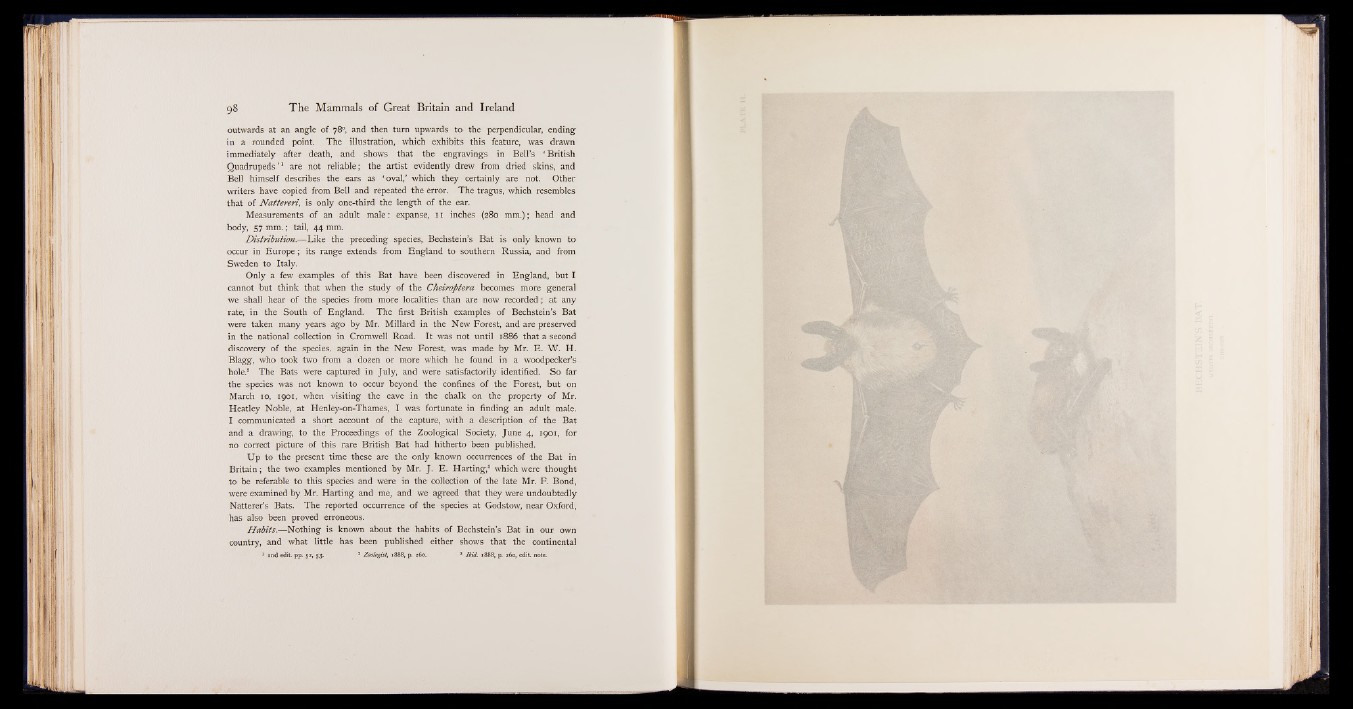
outwards at an angle of 78°, and then turn upwards to the perpendicular, ending
in a rounded point. The illustration, which exhibits this feature, was drawn
immediately after death, and shows that the engravings in Bell’s ‘ British
Quadrupeds’ 1 are not reliable; the artist evidently drew from dried skins, and
Bell himself describes the ears as ‘ oval,’ which they certainly are not. Other
writers have copied from Bell and repeated the error. The tragus, which resembles
that of Nattereri, is only one-third the length of the ear.
Measurements of an adult male: expanse, 11 inches (280 mm.); head and
body, 57 mm.; tail, 44 mm.
Distribution.— Like the preceding species, Bechstein’s Bat is only known to
occur in Europe; its range extends from England to southern Russia, and from
Sweden to Italy.
Only a few examples of this Bat have been discovered in England, but I
cannot but think that when the study of the Cheiroptera becomes more general
we shall hear of the species from more localities than are now recorded; at any
rate, in the South of England. The first British examples of Bechstein’s Bat
were taken many years ago by Mr. Millard in the New Forest, and are preserved
in the national collection in Cromwell Road. It was not until 1886 that a second
discovery of the species, again in the New Forest, was made by Mr. E. W. H.
Blagg, who took two from a dozen or more which he found in a woodpecker’s
hole.2 The Bats were captured in July, and were satisfactorily identified. So far
the species was not known to occur beyond the confines of the Forest, but on
March 10, 1901, when visiting the cave in the chalk on the property of Mr.
Heatley Noble, at Henley-on-Thames, I was fortunate in finding an adult male.
I communicated a short account of the capture, with a description of the Bat
and a drawing, to the Proceedings of the Zoological Society, June 4, 1901, for
no correct picture of this rare British Bat had hitherto been published.
Up to the present time these are the only known occurrences of the Bat in
Britain; the two examples mentioned by Mr. J. E. Harting,8 which were thought
to be referable to this species and were in the collection of the late Mr. F. Bond,
were examined by Mr. Harting and me, and we agreed that they were undoubtedly
Natterer’s Bats. The reported occurrence of the species at Godstow, near Oxford,
has also been proved erroneous.
Habits.— Nothing is known about the habits of Bechstein’s Bat in our own
country, and what little has been published either shows that the continental
1 2nd edit. pp. 52, 53. ’ Zoologist\ 1888, p. 260. 3 Ibid. 1888, p. 260, edit note.